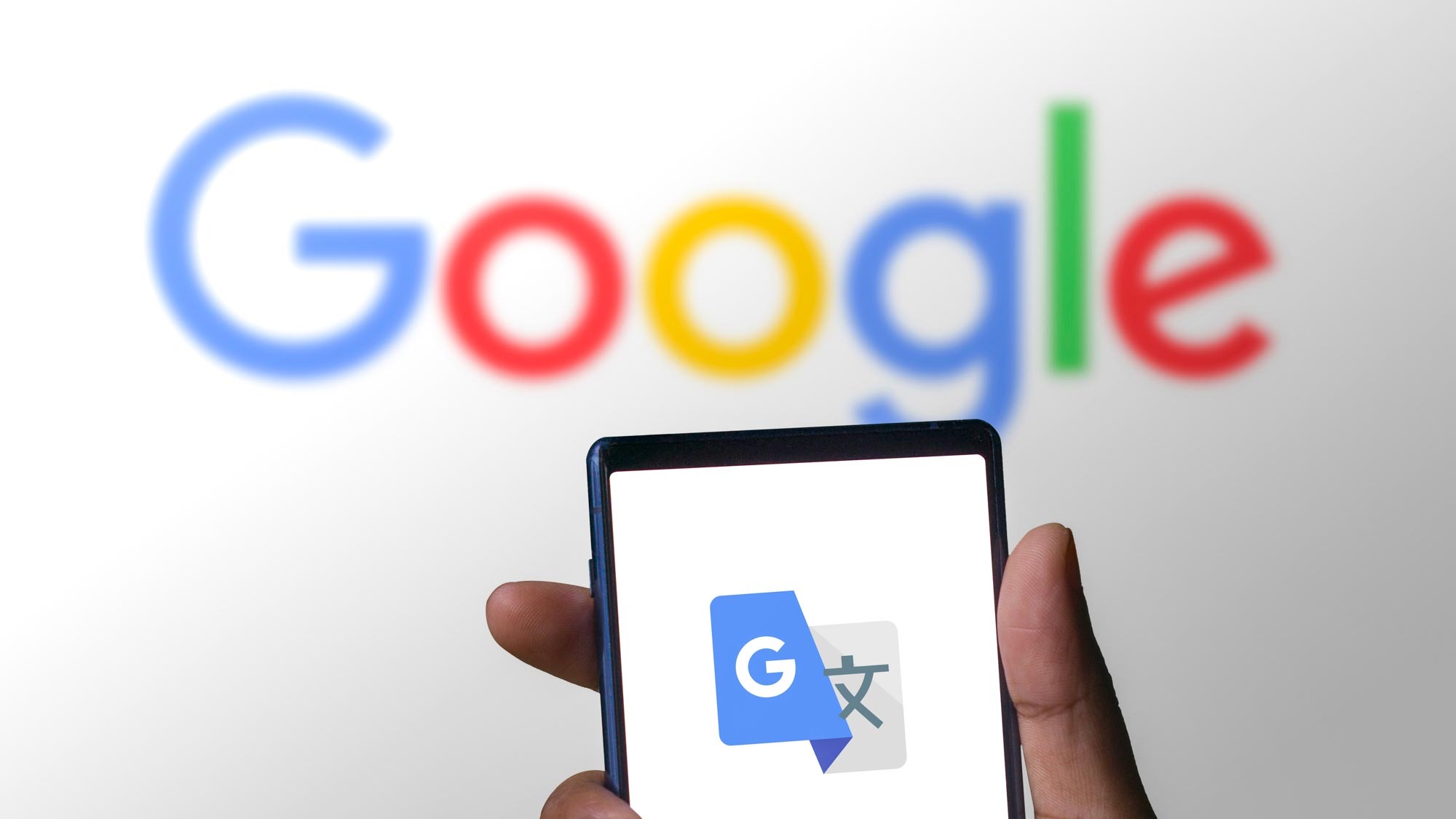Samsung Galaxy S20 Ultra vs iPhone 11 Pro Max: Battle of the giant phones
Which older big-screen flagship is right for you — the Galaxy S20 Ultra or the iPhone 11?
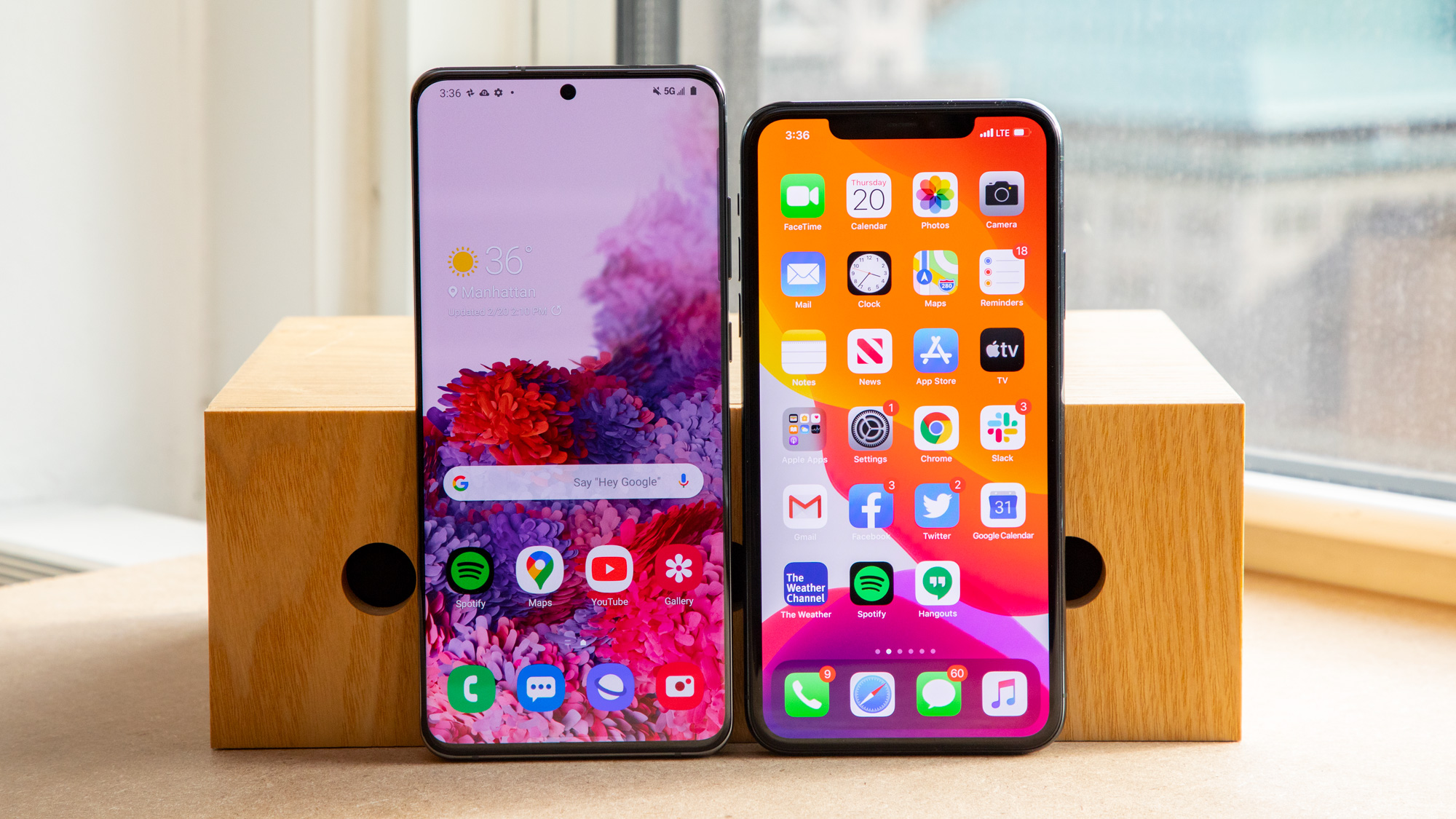
There are more pressing face-offs than the Samsung Galaxy S20 Ultra vs. iPhone 11 Pro Max one, since neither phone is the most up-to-date model offered by Samsung or Apple (For a more recent showdown, check out our iPhone 13 Pro Max vs. Galaxy S21 Ultra comparison.) But seeing how these two older phones measure up against one another is still worthwhile.
Both the Samsung Galaxy S20 Ultra and iPhone 11 Pro Max were once the best phones available — recognizing their relative strengths and weaknesses provides an overview of the smartphone market as a whole. And who knows — there are still older S20 Ultra and iPhone 11 Pro Max models available out there at substantially lower prices. Those two phones still have enough to offer people who favor big-screen phones with other high-end features.
- Best Samsung phones: See the current Galaxy models
- Find the latest Apple devices among the best iPhones
The 6.9-inch Samsung Galaxy S20 Ultra arrived in spring 2020, and it's an epic device in every sense — from its quad-lens, 108-megapixel camera system to its 5G connectivity, 5,000-mAh battery and 120Hz display. It's also a very compelling alternative to the 6.5-inch iPhone 11 Pro Max that debuted in 2019, but has since dropped out of Apple's iPhone lineup.
While not as expensive as they once were, the S20 Ultra and iPhone 11 Pro Max will still cost you, so you'll want to make sure you're choosing the best phone for your needs. Our Samsung Galaxy S20 Ultra vs. iPhone 11 Pro Max face-off will help you suss out the differences between these two big phones.
Samsung Galaxy S20 Ultra vs iPhone 11 Pro Max: Price
The Galaxy S20 Ultra's price tag was quite astronomical when it first debuted. At $1,399 for the base configuration of the S20 Ultra with 128GB of storage and 12GB of RAM, Samsung's flagship commanded a $300 premium over the cheapest version of the iPhone 11 Pro Max with 64GB of storage.
These days, you can generally find the Galaxy S20 Ultra for less, though it's harder to come by at wireless carriers. That said, Best Buy is selling a version of the Galaxy S20 Ultra for $600 off as of this writing. Should you opt for the S20 Ultra at this stage, make sure you can get it for less than $1,199 — the asking price of a newer Galaxy S21 Ultra.
As for the iPhone 11 Pro Max, it's also harder to come by now that it's two generations old and long since remove from Apple's product lineup. Prices have fallen by around $400 from the iPhone 11 Pro Max's original price.
Get instant access to breaking news, the hottest reviews, great deals and helpful tips.
Winner: iPhone 11 Pro Max
Samsung Galaxy S20 Ultra vs iPhone 11 Pro Max: Specs
| Row 0 - Cell 0 | Samsung Galaxy S20 Ultra | iPhone 11 Pro Max |
| Display | 6.9-inch AMOLED (3200x1440; 120 Hz) | 6.5-inch OLED (2688x1242) |
| Rear cameras | Quad lens: 108 MP wide (ƒ/1.8), 48-MP telephoto (ƒ/3.5); 12 MP ultrawide (ƒ/2.2); time-of-flight VGA | Triple lens: 12 MP wide (ƒ/1.8), 12-MP telephoto (ƒ/2.0) 12 MP ultrawide (ƒ/2.4) |
| Camera zoom | 10x lossless zoom, 100x digital zoom | 2x optical zoom, 10x digital zoom |
| Front camera | 40 MP (ƒ/2.2) | 12 MP (ƒ/2.2) |
| Cellular networks | Up to 5G (sub-6GHz and mmWave) | Up to 4G LTE |
| Video | Up to 8K resolution at 24 fps | Up to 4K resolution at 60 fps |
| CPU | Qualcomm Snapdragon 865 | Apple A13 Bionic |
| RAM | 12GB, 16GB | 4GB |
| Storage | 128GB, 512GB | 64GB, 256GB, 512GB |
| microSD | Yes, up to 1TB | No |
| Battery | 5,000 mAh | 3,969 mAh |
| Size | 6.6 x 2.7 x 0.34 inches | 6.22 x 3.06 x 0.32 inches |
| Weight | 7.7 ounces | 7.97 ounces |
Samsung Galaxy S20 Ultra vs iPhone 11 Pro Max: Design
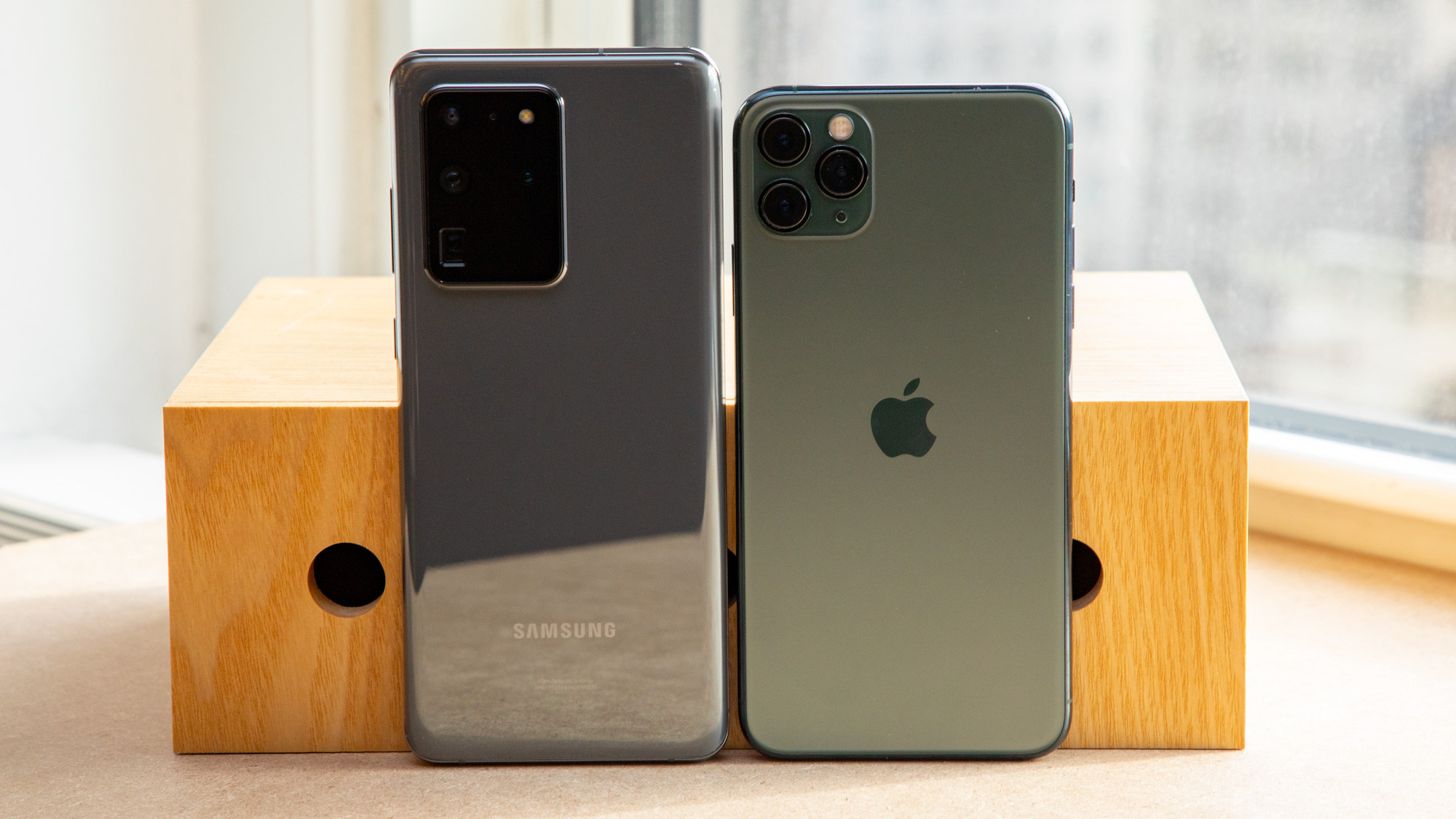
At 6.5 inches from corner to corner, the iPhone 11 Pro is an imposing smartphone. But the Galaxy S20 Ultra takes things a step further with its largest-in-class 6.9-inch AMOLED panel. Samsung's handset also employs a 20:9 aspect ratio that's slightly narrower than the iPhone 11 Pro Max's squatter 19.5:9 proportions.
As a result, the Galaxy S20 Ultra is considerably taller than Apple's supersized iPhone, yet not quite as wide. Because the S20 Ultra is a hair narrower, Samsung's device is actually a bit easier to grasp in your hand. On the flip side, the additional three-tenths of an inch of height means you have to stretch your thumb farther across the Galaxy's display to reach the opposite corner.
Make no mistake: Those shopping for one of the best small phones aren't going to be comfortable with either of these handsets. But aesthetically speaking, the iPhone 11 Pro Max feels a bit more premium and distinctive, with its stainless steel frame, matte glass back, meticulously designed triple-lens rear camera array and selection of color options. The S20 Ultra, by comparison, is only available in Cosmic Black and Cosmic Gray — both of which look very boring.
Winner: iPhone 11 Pro Max
Samsung Galaxy S20 Ultra vs iPhone 11 Pro Max: Display
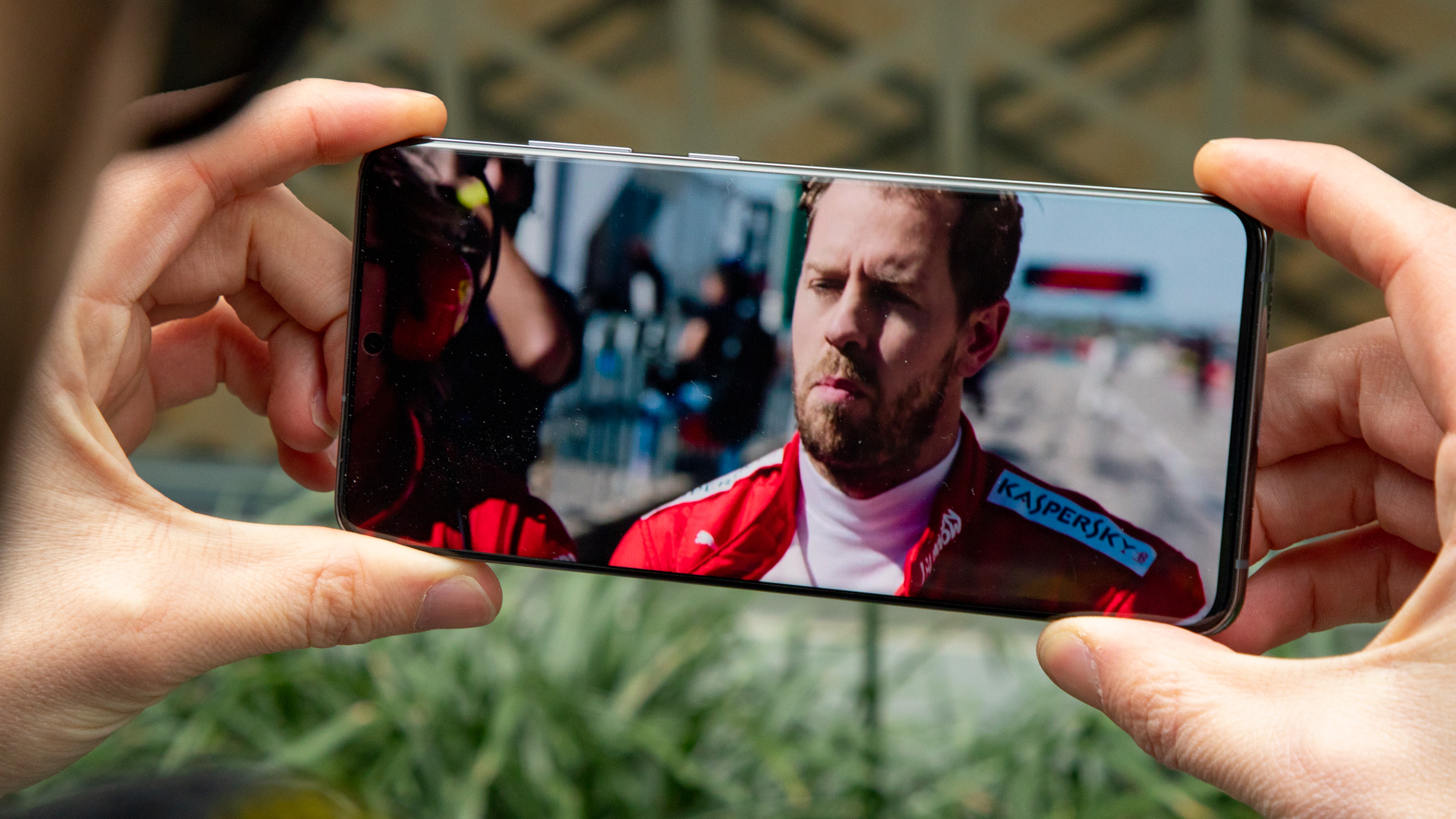
The Galaxy S20 Ultra's 6.9-inch display sports both a higher resolution and a peak refresh rate that's double the 6.5-inch panel inside the iPhone 11 Pro Max, so you might expect Samsung to pull out a massive lead in this category.
However, there are a few caveats to those eye-catching specs. The S20 Ultra defaults to full-HD resolution, rather than its native quad HD. The default refresh rate mode is also 60Hz, even though the phone can be set to 120Hz for smoother animations and scrolling. (Raising the refresh rate imposes an adverse effect on battery life, but we'll get to that later.) If you want a dynamically refreshing display, you'll have to turn to one of Samsung's newer S21 models. Apple didn't add the feature to its phones until this past fall, when the iPhone 13 Pro and iPhone 13 Pro Max introduced dynamically refreshing displays.
But to compare things to the iPhone 11 Pro Max, while the S20 Ultra's display can look better than the iPhone's, it doesn't come out of the box that way. To get the best longevity on a charge, you won't want to keep it locked on those energy-draining settings.

What's more, the iPhone 11 Pro Max's panel was able to reach a higher peak brightness setting in our lab, churning out 761 nits to the S20 Ultra's 662 nits. Apple's screen tuning also opts for more muted, realistic colors, whereas Samsung provides several options on its devices, ranging from natural to Adaptive. The latter lends a noticeably more saturated look to photos, movies and games.
In the end, the S20 Ultra gets the nod here on the basis of its faster refresh rate, but only just. While Samsung's display breakthroughs are no doubt very impressive, they're not necessarily efficient enough to use every day — at least not in this 2020 edition of the phone.
Winner: Samsung Galaxy S20 Ultra
Samsung Galaxy S20 Ultra vs iPhone 11 Pro Max: Camera

Whether you choose the Galaxy S20 Ultra or the iPhone 11 Pro Max, you're getting one of the best camera phones money can buy (at least at the time we originally did this comparison). However, one of these older phones still has an edge.
The spec sheet would have you believe it’s the Galaxy. Sure, the iPhone 11 Pro Max features three 12-MP sensors on the back, tied to wide, ultrawide and 2x optical telephoto lenses. But the Galaxy S20 Plus sports a 108-MP primary wide lens; a 48-MP, 4x optical telephoto capable of 10x lossless hybrid zoom; a 12-MP ultrawide shooter; and a time-of-flight sensor for depth-measuring capabilities.
In some cases, such as when you can take advantage of the S20 Ultra’s zoom capabilities, the results just speak for themselves. The iPhone 11 Pro Max's camera is good — very good. But it often has a preference for artificially warm images, and its purely digital zoom is no match for the S20 Ultra's software-aided optical zoom that delivers lossless quality at 10x.
However, the S20 Ultra also has a habit of trying too hard sometimes — especially when things get dark. To its credit, Samsung’s device delivered a sharper image here that extracted more detail out of the ceiling and floor. But the white balance is a bit too cool, and the contrast is over pronounced compared to the more naturally-toned scene captured on the iPhone.
Plus, the iPhone 11 Pro Max still holds an advantage where portraits are concerned. While Apple's cameras muddied up my skin tone and lent a sepia-like cast to the frame, they also pulled out much more detail in my hair and the fabric of my scarf and jacket. The optimal portrait would combine the metering of the S20 Ultra's shot with the detailed exposure visible in the iPhone's.
Likewise, there are aspects I prefer of the selfie I captured using the iPhone 11 Pro Max. Apple's Deep Fusion camera technology excels at highlighting fine detail in medium lighting conditions. The S20 Ultra doesn't really have an answer to that technique, though I do prefer the more flattering, zoomed-in perspective of Samsung's 40-MP selfie lens.
It must be said that the Galaxy S20 Ultra has a few helpful camera interface features that the iPhone lacks. Single Take, for example, captures a variety of content types with just one press of the shutter button — including wide and ultrawide photos, short video clips and a preselected best shot. The S20 Ultra can also capture 8K video, though you'll obviously need an 8K display to view that content as it was intended to be seen.
However, those benefits don’t outweigh the glitches many had discovered within the S20 Ultra’s imaging stack, though the company issued a software update to address these problems. Subsequent software updates have supported more camera features on the S20 Ultra. Even so, the iPhone remains a more reliable camera, despite its decidedly less impressive specs.
Winner: iPhone 11 Pro Max
Samsung Galaxy S20 Ultra vs iPhone 11 Pro Max: Performance
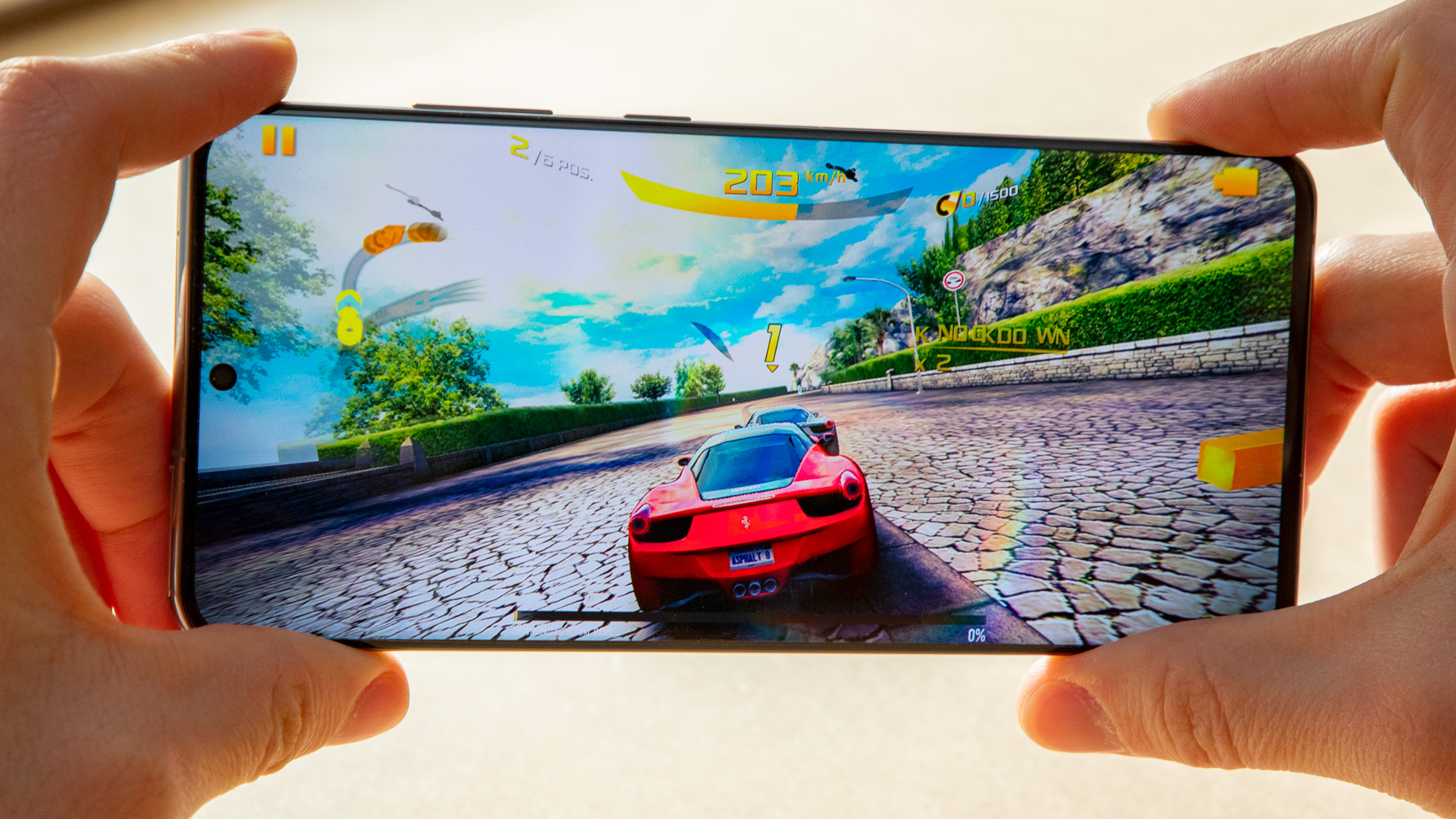
Here's one particular area where Samsung — and other Android phone makers — still have some serious catching up to do. The A13 Bionic chipset in the iPhone 11 Pro Max surpasses the Qualcomm Snapdragon 865 chipset inside the Galaxy S20 Ultra, just like it beat phones powered by last year's Snapdragon 855 system-on-chip. (And that's continued even now with the newer iPhones' A15 Bionic chip and the Qualcomm Snapdragon 888 powering the latest Android flagships.)
Now, rest assured — the S20 Ultra, with its 12GB of RAM compared with the iPhone's 4GB, is no slouch. But Apple's still a step ahead of the Snapdragon contingent, judging from the benchmarks.
For example, in Geekbench 5's multicore, systemwide test, the S20 Ultra delivered a score of 3,076, compared with the iPhone's 3,517. In GFXBench's Aztec Ruins high-tier off-screen graphics test, the S20 Ultra pulled a 1,319 result at 20.7 frames per second, compared with 1,657 at 25 fps for Apple's flagship. If maximum performance is a major priority for you, iPhone remains the answer.
Winner: iPhone 11 Pro Max
Samsung Galaxy S20 Ultra vs iPhone 11 Pro Max: 5G and connectivity
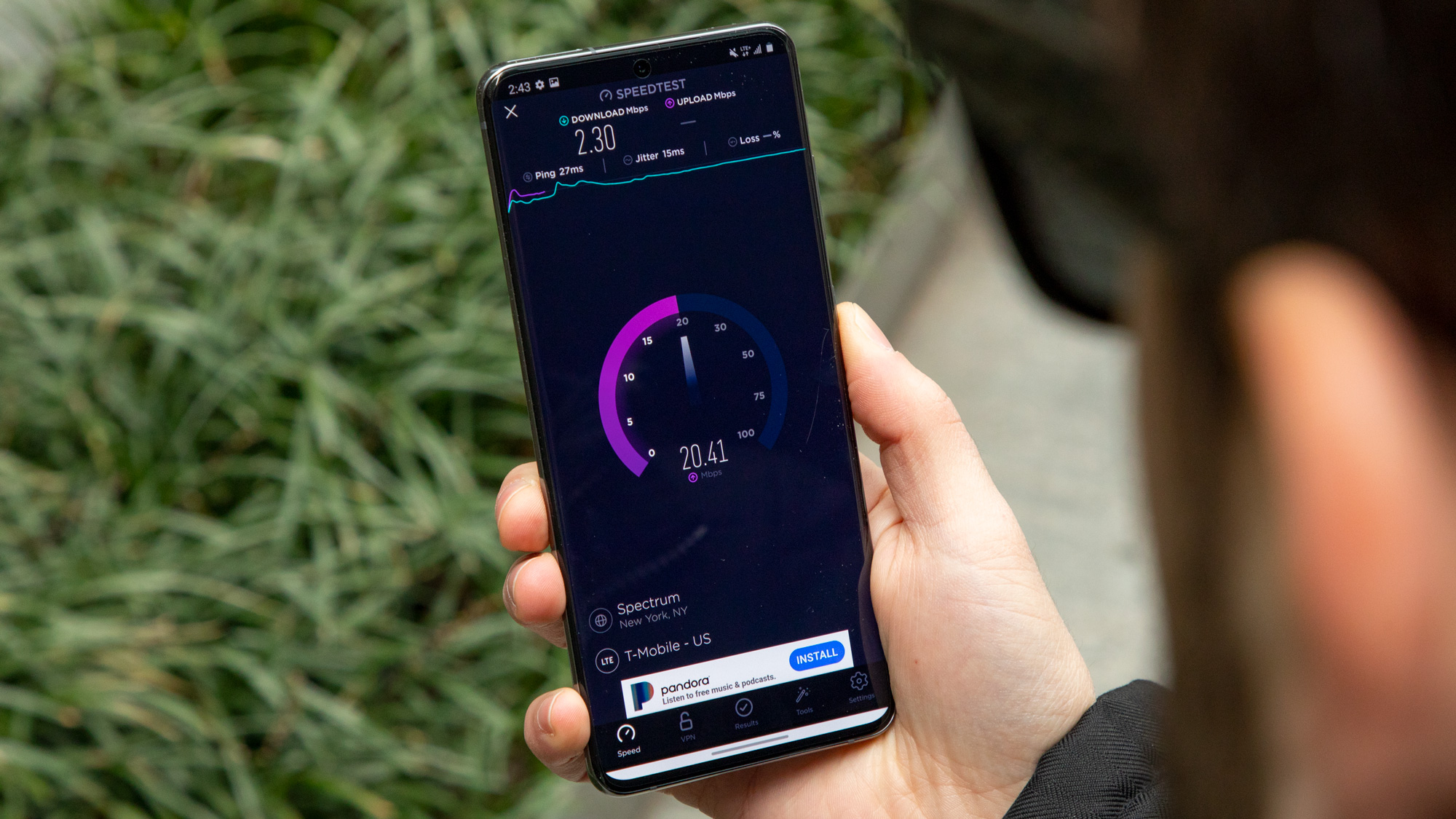
The Galaxy S20 Ultra can connect to any major carrier's 5G network, while the iPhone 11 Pro Max has to make do with pedestrian 4G LTE. Apple didn't add 5G until the iPhone 12 in late 2020.
If you were spending more than $1,000 on a new smartphone last year, you were going to want one with 5G. Not so much then, but rather in the coming years. Even now, people who've opted for the S20 Ultra can enjoy improving 5G networks, while the iPhone 11 Pro Max will forever be stuck on LTE.
Right now, 5G speeds aren't all they're cracked up to be. Millimeter wave (mmWave) performance delivers exceptional download speeds well beyond 1 Gbps. But to get that, you have to stand outdoors, within line of sight of a node on a telephone pole or building. Meanwhile, broader sub-6-GHz 5G coverage is accessible indoors, but sort of performs like really good LTE, offering speeds hovering around 100 Mbps on T-Mobile's 5G network in New York on the S20 Ultra.
Ultimately, networks figure to improve over time, and because the Galaxy S20 Ultra's X55 modem works with different kinds of 5G, it stands to reap those benefits as you hold onto your phone.
Winner: Samsung Galaxy S20 Ultra
Samsung Galaxy S20 Ultra vs iPhone 11 Pro Max: Battery life
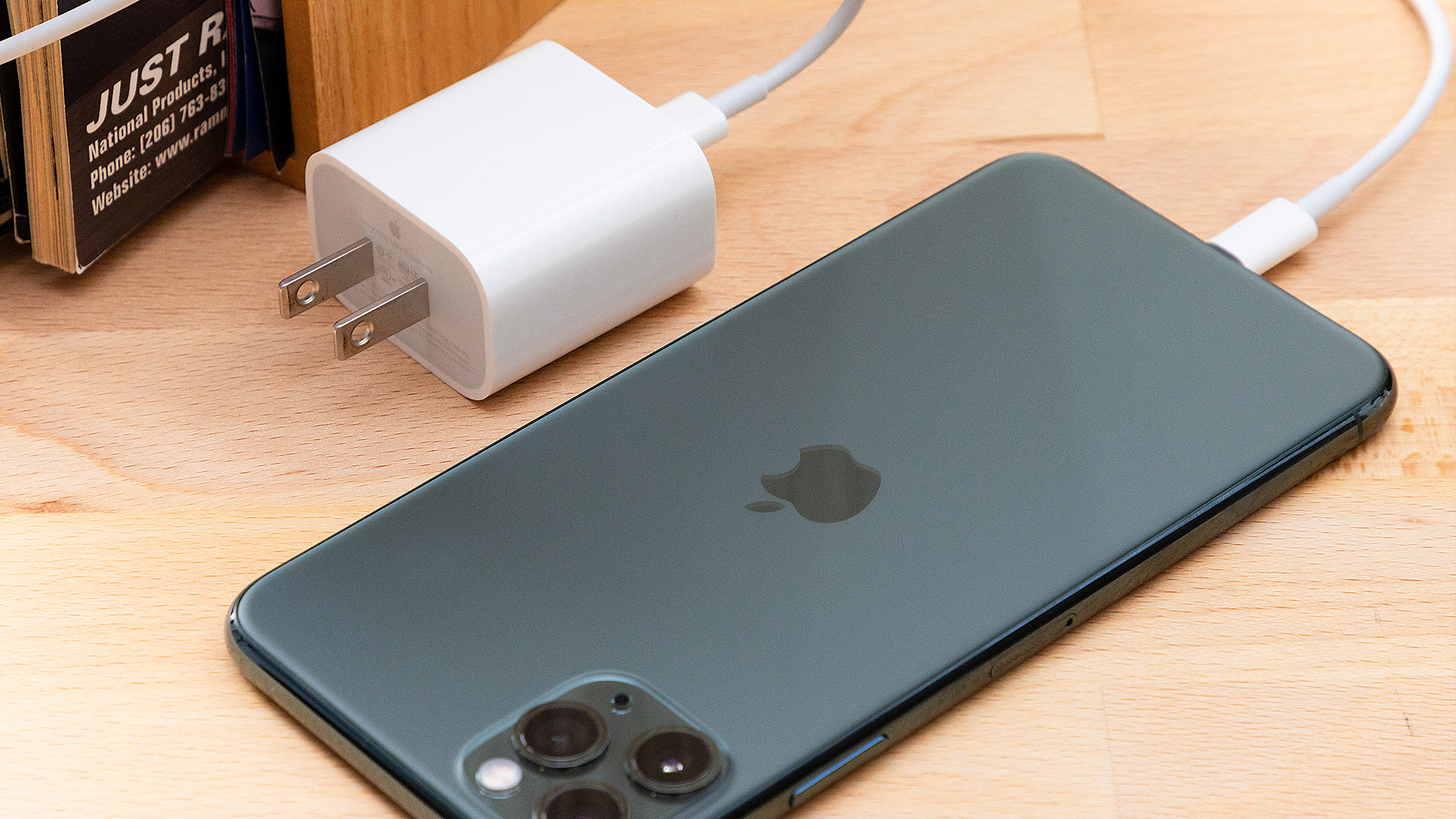
The Galaxy S20 Ultra averaged 11 hours and 58 minutes in Tom's Guide's custom battery test, where phones are made to endlessly load web pages over a mobile network (in this case, T-Mobile 5G) while set to 150 nits of screen brightness. The iPhone 11 Pro Max lasted essentially just as long, at 11 hours and 54 minutes.
That would place both of these flagships near the the top of our list of the longest-lasting smartphones. (We ease phones off that list after they've been out for a year-and-a-half.) However, there's a catch. Remember when we said the S20 Ultra has a 120-Hz screen? That 11:58 time was recorded with the phone's display set to 60 Hz, and you definitely won't get the same longevity when using the high refresh-rate mode.
In fact, Samsung's handset won't come anywhere close to that number, should you opt for 120 Hz. It turns out the Galaxy S20 Ultra's battery life is reduced by a quarter when you ratchet up the refresh rate, going from about 12 hours to 9 hours — something prospective owners should certainly keep in mind.
Surprisingly, the S20 Ultra even charges back up faster than the iPhone 11 Pro Max, even though it has a much larger battery. The 25-watt adapter included with the S20 Ultra replenished 63% of the device's charge after a half hour, compared with 48% for the 18-watt brick that ships with the iPhone. The S20 Ultra can also wirelessly charge other devices — like, perhaps, a pair of Galaxy Buds or a smartwatch — another thing Apple's handset cannot do.
Winner: Samsung Galaxy S20 Ultra
Samsung Galaxy S20 Ultra vs iPhone 11 Pro Max: Software
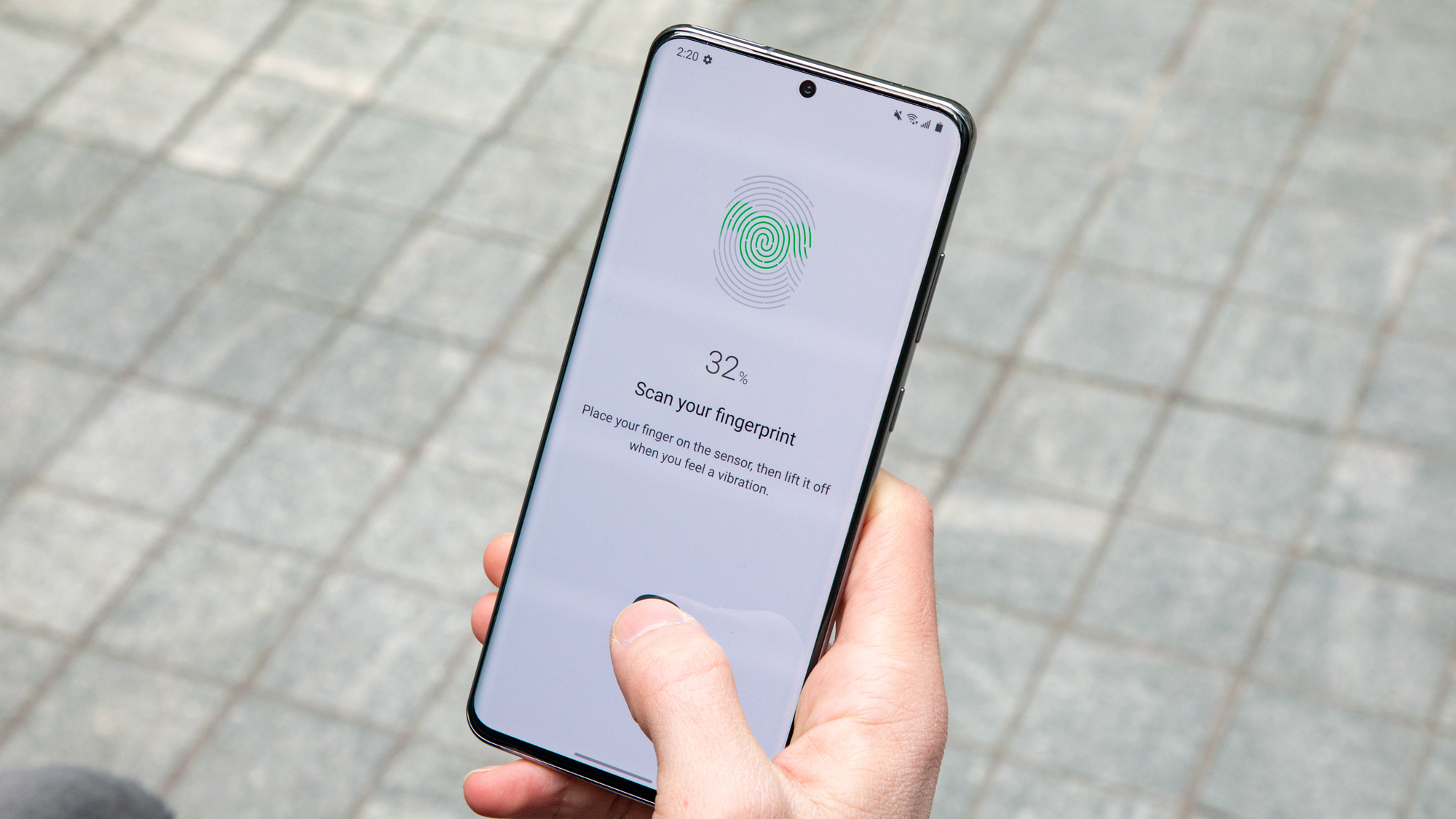
The Galaxy S20 Ultra and iPhone 11 Pro Max each come out of the box with the latest versions of their respective operating systems at the time of launch: Android 10 (featuring Samsung's One UI 2 interface) and iOS 13. We found the latter to be a more meaningful upgrade when we reviewed both releases late last year, thanks to Apple's well-designed new Dark Mode, improved Maps and Photos apps and privacy-protecting and time-saving Sign in with Apple feature.
These days, the iPhone 11 Pro Max easily runs iOS 15, and it should continue to support Apple software updates for a few years. Likewise, the Galaxy S20 Ultra has been updated to Android 11, though we're not expecting Android 12 to reach the phone until the end of 2021 at the earliest.
Even with most of us wearing masks these days, Face ID — Apple's secure, 3D face-scanning biometric technology — remains a great way to unlock your phone and verify mobile payments. Samsung still has no answer to it, and the ultrasonic fingerprint sensor it's used on the S20 Ultra instead is rather clunky and inaccurate.
Winner: iPhone 11 Pro Max
Overall Winner: iPhone 11 Pro Max
It's hard to ignore that the Samsung Galaxy S20 Plus gives you everything plus the kitchen sink. If you want the best phone but don't want to pay up for a current model, there's really nothing (save for a headphone jack) you could ask for that the S20 Ultra doesn't have.
| Row 0 - Cell 0 | Samsung Galaxy S20 Ultra | iPhone 11 Pro Max |
| Price (10) | 4 | 5 |
| Design (15) | 11 | 13 |
| Camera (20) | 16 | 18 |
| Display (10) | 10 | 8 |
| Performance (15) | 13 | 14 |
| Connectivity (5) | 5 | 3 |
| Battery (15) | 13 | 11 |
| Software (10) | 7 | 10 |
| Total (100) | 79 | 82 |
However, the price of the Galaxy S20 Ultra remains pretty high, even with newer Samsung phones available. The iPhone 11 Pro Max is still significantly cheaper than Samsung's Ultra phones and slightly better than the S20 Ultra in ways that will likely matter to more people — namely, with regard to its more intuitive, regularly updated software, exceptional performance and attractive design.
Ultimately, you shouldn't regret purchasing either of these phones, though at this stage in their life cycle, make sure you're paying as little as possible. No matter which device you buy, they're both stunning options that leave nothing on the table.
At the time of its release, the Galaxy S20 Ultra represented where the industry was headed, but the original price was just out of reach, the advantages are negligible, and Samsung refined many of the features it introduced on the newer Galaxy Note 20 Ultra. But the iPhone 11 Pro Max remains a better big-screen phone overall.
Adam Ismail is a staff writer at Jalopnik and previously worked on Tom's Guide covering smartphones, car tech and gaming. His love for all things mobile began with the original Motorola Droid; since then he’s owned a variety of Android and iOS-powered handsets, refusing to stay loyal to one platform. His work has also appeared on Digital Trends and GTPlanet. When he’s not fiddling with the latest devices, he’s at an indie pop show, recording a podcast or playing Sega Dreamcast.
